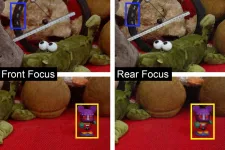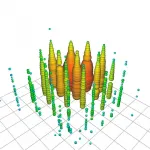Hip fracture outcomes worse during busy periods
Elderly people are at greater risk of dying from hip surgery if surgeons are in a hurry
2021-03-10
(Press-News.org) Hip fractures are serious, especially for the elderly. The operation can be a great strain, and 13 per cent of patients over the age of 70 do not survive 60 days after the fracture.
Their chance of survival may depend on how busy the surgeons are with other emergency procedures.
"When the operating room is busy, 20 per cent more of the patients die within 60 days after the operation," says Professor Johan Håkon Bjørngaard at the Norwegian University of Science and Technology's (NTNU) Department of Public Health and Nursing.
Surgeons can get especially busy during periods when the patient demand for surgery is high. In busy periods, hip fracture patients have to wait on average 20 per cent longer before being operated on compared to the quiet periods. This wait can have serious consequences.
Information from more than 60 000 hip surgeries and all simultaneous emergency surgeries provided the research group from St. Olavs Hospital and NTNU with a solid numerical basis.
"We investigated how many older people over the age of 70 died during the first 60 days following a hip operation when particularly many emergency patients were queued up for surgery at the hospitals," say researchers Andreas Asheim and Sara Marie Nilsen from the Regional Center for Health Services Development (RSHU) at St. Olavs hospital.
During busy periods, 40 per cent of the patients waiting in the operating wards are typically people who have recently been brought in for emergency surgery. In the quietest periods, the percentage can drop to 25 per cent.
Older people often have to undergo surgery for hip fractures. The average age of hip surgery patients in the study was 85, with women making up 72 per cent. The median wait time before being operated on was about 20 hours.
Older people naturally have a greater risk of dying than the average population has. Age is one reason why mortality is high following surgery.
The capacity of the hospitals also plays a major role.
Previous results show that patients who are operated on for hip fractures have a higher risk of dying if they are discharged from the hospital early due to lack of space.
Hip fracture patients may need to be prioritized in the queue to increase their chances of survival.
Prioritizing patients "is part of a discussion about organizing emergency surgery. This could mean that we need to screen surgery hip fracture patients more than what's currently being done," says orthopaedist Lars Gunnar Johnsen.
INFORMATION:
ELSE PRESS RELEASES FROM THIS DATE:
2021-03-10
Bone is not just a fixed material - it's a dynamic set of structures that can adapt their mass and strength based on the loads they must support.
Developing that sort of adaptive material has long been the dream of scientists. Now for the first time, scientists at the Pritzker School of Molecular Engineering (PME) at the University of Chicago have developed a gel material that strengthens when exposed to vibration.
Not only were scientists able to make the material 66 times stronger through vibrations, they were also able to strengthen only the areas exposed to movement. That sort of specificity could lead to new adhesives and ...
2021-03-10
Scientists have developed a see-through glass display with a high white light contrast ratio that smoothly transitions between a broad spectrum of colors when electrically charged. The technology, from researchers at Jilin University in Changchun, China, overcomes limitations of existing electrochromic devices by harnessing interactions between metal ions and ligands, opening the door for numerous future applications. The work appears March 10 in the journal Chem.
"We believe that the method behind this see-through, non-emissive display may accelerate the development of transparent, eye-friendly displays with improved readability for bright working conditions," says Yu-Mo Zhang, an associate professor of chemistry at Jilin ...
2021-03-10
The cryptocurrency market has been abuzz as Bitcoin gains popularity with investors, reaching an all-time high of over $58,000 apiece in February. In a commentary published March 10 in the journal Joule, financial economist Alex de Vries quantifies how the surging Bitcoin price is driving increasing energy consumption, exacerbating the global shortage of chips, and even threatening international safety.
Theoretically, any computer with access to the internet and electricity can "mine" Bitcoin, a process to receive cryptocurrency by solving sophisticated mathematical equations. It is estimated that all miners combined make over 150 quintillion--that is 18 zeros following 150--attempts every second to solve the equation, according to numbers from January 11, 2021. Computational power ...
2021-03-10
Scientists and healthcare providers are beginning to use a new approach for assessing a person's inherited risk for diseases like Type 2 diabetes, coronary heart disease and breast cancer, which involves calculating a END ...
2021-03-10
When we think about the causes of neurological disorders and how to treat them, we think about targeting the brain. But is this the best or only way? Maybe not. New research by scientists at Baylor College of Medicine suggests that microbes in the gut may contribute to certain symptoms associated with complex neurological disorders. The findings, published in the journal Cell, also suggest that microbe-inspired therapies may one day help to treat them.
Dr. Mauro Costa-Mattioli, professor and Cullen Foundation Endowed Chair in neuroscience and director of the Memory and Brain Research Center at Baylor, discovered ...
2021-03-10
Ottawa, March 10, 2021 - A new study of fossilized lampreys dating from more than 300 million years ago is challenging a long-held theory about the evolutionary origin of vertebrates (all animals with a backbone). The findings are published March 10 in the science journal Nature.
Lampreys are ancient, jawless, eel-like fishes that arose around half a billion years ago and they have long provided insights into vertebrate evolution. Now, scientists with the Canadian Museum of Nature, the University of Chicago and the Albany Museum in South Africa are reporting their analysis of dozens of tiny fossils that track the life stages and growth of ancient lampreys, from hatchlings to juveniles to adults.
Their results counter the established view that the blind, filter-feeding ...
2021-03-10
A new study out of the University of Chicago, the Canadian Museum of Nature and the Albany Museum challenges a long-held hypothesis that the blind, filter-feeding larvae of modern lampreys are a holdover from the distant past, resembling the ancestors of all living vertebrates, including ourselves. The new fossil discoveries indicate that ancient lamprey hatchlings more closely resembled modern adult lampreys, and were completely unlike their modern larvae counterparts. The results were published on March 10 in Nature.
Lampreys -- unusual jawless, eel-like, creatures -- have long provided insights ...
2021-03-10
Despite years of hype, virtual reality headsets have yet to topple TV or computer screens as the go-to devices for video viewing. One reason: VR can make users feel sick. Nausea and eye strain can result because VR creates an illusion of 3D viewing although the user is in fact staring at a fixed-distance 2D display. The solution for better 3D visualization could lie in a 60-year-old technology remade for the digital world: holograms.
Holograms deliver an exceptional representation of 3D world around us. Plus, they're beautiful. (Go ahead -- check out the holographic dove on your Visa card.) Holograms offer a shifting perspective based on the viewer's position, and they allow the eye to adjust focal depth to alternately focus on foreground and background.
Researchers have long sought ...
2021-03-10
On December 6, 2016, a high-energy particle called an electron antineutrino hurtled to Earth from outer space at close to the speed of light carrying 6.3 petaelectronvolts (PeV) of energy. Deep inside the ice sheet at the South Pole, it smashed into an electron and produced a particle that quickly decayed into a shower of secondary particles. The interaction was captured by a massive telescope buried in the Antarctic glacier, the IceCube Neutrino Observatory.
IceCube had seen a Glashow resonance event, a phenomenon predicted by Nobel laureate physicist ...
2021-03-10
Researchers have struck quantum gold--and created a new word--by enlisting machine learning to efficiently navigate a 20-dimensional quantum treasure map.
Physicist Dr Markus Rambach from the ARC Centre of Excellence for Engineered Quantum Systems (EQUS) at The University of Queensland said the team was able to find unknown quantum states more quickly and accurately, using a technique called self-guided tomography.
The team also introduced the 'quvigint', which is like a qubit (the quantum version of a classical bit that takes on the values '0' or '1') except that it takes on not two, but 20 possible values.
Dr ...
LAST 30 PRESS RELEASES:
[Press-News.org] Hip fracture outcomes worse during busy periods
Elderly people are at greater risk of dying from hip surgery if surgeons are in a hurry




